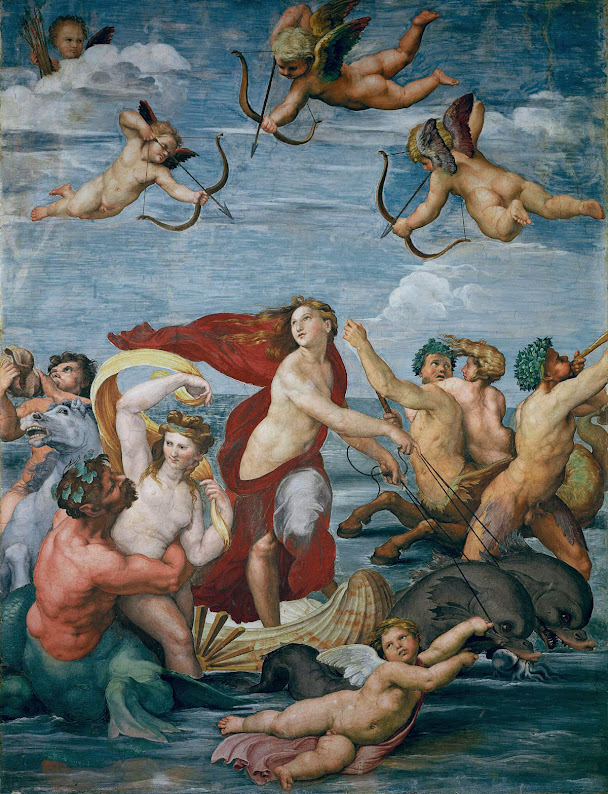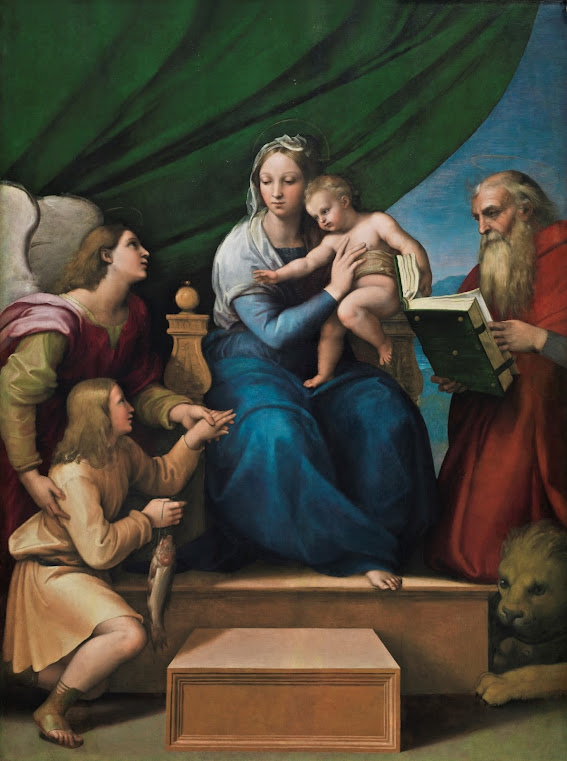For centuries Raphael has been recognised as the supreme High Renaissance painter, more versatile than Michaelangelo and more prolific than their older contemporary Leonardo. Though he died at 37, Raphael's example as a paragon of classicism dominated the academic tradition of European painting until the mid-19th century.
Raphael (Raffaello Santi) was born in Urbino where his father, Giovanni Santi, was court painter. He almost certainly began his training there and must have known works by Mantegna, Uccello, and Piero della Francesca from an early age. His earliest paintings were also greatly influenced by Purgino. From 1500 - when he became an independent master - to 1508 he worked throughout central Italy, particularly Florence, where he became a noted portraitist and painter of Madonnas.
In 1508, at the age of 25, he was called to the court of Pope Julius II to help with the redecoration of the papal apartments. In Rome he evolved as a portraitist, and became one of the greatest of all history painters.
He remained in Rome for the rest of his life and in 1514, on the death of Bramante, he was appointed architect in charge of St Peter’s.
For earlier works see parts 1 - 3 also.
This is part 4 of 5 parts on the works of Raphael:
 |
| c1508 Virgin and Child with the Young Saint John the Baptist (The Esterházy Madonna) oil on canvas 28.5 x 21.5 cm Museum of Fine Arts Budapest |
 |
| c1508 Virgin and Child with the Young Saint John the Baptist ( study for the above ) pen and brown ink over black chalk 28.7 x 19.2 cm Uffizi Gallery, Florence |
 |
| 1509 La Madone de Lorette oil on wood panel 120 x 90 cm Musée Condé, Château de Chantilly, Oise, France |
 |
| 1509 Reading Madonna and Child in a Landscape betweem two Cherub Heads pen and brown ink over traces of stylus Albertina, Venice |
c1509-10 The Madonna and Child with the Infant Baptist
Notes by The National Gallery
In this little picture Raphael depicts the moment when the Christ Child takes a carnation, traditionally symbolic of divine love and the Passion (Christ’s torture and crucifixion), from his cousin John the Baptist’s hand. The space between the children’s hands is the centre of the careful geometry of the composition, emphasising this important moment of Christ’s acceptance of his future sacrifice for humanity. The Virgin appears lost in melancholy thought. Perhaps she is thinking of the children’s destinies.
The picture is one of several small and medium-sized Madonnas that Raphael produced at the same time as he was painting a suite of rooms in the Vatican palace for the pope, the so-called stanze. It was probably made for a member of the papal court for private devotion, although we do not know who commissioned it. The painting is known as the Garvagh Madonna or Aldobrandini Madonna after its previous owner.
 |
| c1509-10 The Madonna and Child with the Infant Baptist (The Garvagh Madonna aka The Aldobrandini Madonna) oil on wood panel 38.9 x 32.9 cm The National Gallery, London |
c1509-11 The Madonna and Child
Notes from The National Gallery
The infant Christ throws his arms affectionately around his mother’s neck and smiles at us. But the Virgin Mary’s eyes are downcast, as though her thoughts are already on his future sacrifice.
The painting probably dates from the early years of Raphael’s time in Rome. It is called the ‘Mackintosh Madonna’ after the person who donated it to the National Gallery. It is also known as the ‘Madonna of the Tower’ because of the building just visible in the left background.
 |
| c1509-11 The Madonna and Child (The Mackintosh Madonna) oil on canvas, transferred from wood (largely repainted) 78.8 x 64.2 cm The National Gallery, London |
 |
| 1509-1510 Madonna de Loreto oil on wood panel 120 x 90 cm Musée Condé, Château de Chantilly in Chantilly, Oise |
 |
| c1509-1510 Study for the figure of Diogenes in the "School of Athens" silver point on paper 24.5 x 28.4 cm Städel Museum, Frankfurt, Germany |
 |
| 1509-1511 Study for the Disputation of the Holy Sacrament pen and brown ink 31.1 x 20.8 cm The J. Paul Getty Museum, Los Angeles, CA |
 |
| c1509-1511 Portrait of Cardinal Alessandro Farnese oil on wood panel 139 x 91 cm Museo de Capodimonte, Naples |
 |
| c1509-1515 Portrait of Tommaso Inghirami oil on wood panel 91 x 61 cm Palantine Gallery, Pitti Palace, Florence |
 |
| c1510-15-18 Madonna with the Blue Diadem oil on wood panel 68 x 48 cm Louvre, Paris |
 |
| c1510-1511 Portrait of a Cardinal oil on wood panel 79 x 61 cm Museo del Prado, Madrid |
 |
| c1510-1511 Study for the Figure of Melpomene pen and brown ink over blind stylus 33 x 21.9 cm Ashmolean Museum, University of Oxford |
 |
| c1510-1511 The Adoration of the Shepherds pen and brown ink on white paper 40.5 x 26.6 cm Ashmolean Museum, University of Oxford |
 |
| c1510-1511 The Angel appearing to Joachim pen and brush in yellowish-brown wash over black chalk heightened with white bodycolour 31.4 x 27.6 cm Ashmolean Museum, University of Oxford |
 |
| c1510 Allegorical Figure of Theology pen and brown ink 20.1 x 14.3 cm Ashmolean Museum, University of Oxford |
 |
| c1510 The Prophets Hosea and Jonah pen and brown ink with brown wash over black chalk, heightened with white and squared for transfer 26.2 x 20 cm National Gallery of Art, Washington, DC |
1511 Portrait of Pope Julius II
Notes by The National Gallery
This portrait of the careworn Pope Julius II (1443–1513) is usually dated to the one-and-a-half-year period during which he wore a beard. He grew it in 1510 as a token of mortification while recovering from a serious illness brought on by the loss of Bologna to the French, and vowed not to shave it off until French troops had been expelled from Italy, which happened in 1512. Julius was a great patron of the arts, commissioning Raphael to decorate the papal apartments in the Vatican and ordering the rebuilding of St Peter’s in Rome.
The two golden acorns on the Pope’s chair allude to his family name, della Rovere (rovere is Italian for oak). The portrait was displayed on 12 December 1513, after Julius’s death, in the Roman church of Santa Maria del Popolo. It was enormously influential and became the model for ecclesiastical portraiture over the following 200 years.
 |
| 1511 Portrait of Pope Julius II oil on poplar panel 108.7 x 81 cm The National Gallery, London |
 |
| c1511-1512 Madonna of Foligno oil on wood transferred to canvas 320 x 194 cm Pinacoteca Vaticana, Vatican City |
 |
| c1511 Alba Madonna oil on wood transferred to canvas 94.5 cm diameter National Gallery of Art, Washington, DC |
 |
| c1511 Alba Madonna preparatory sketch pen and ink 42.2 x 27.2 cm Palais des Beaux-Arts de Lille, Belgium |
 |
| c1511 Madonna of Loreto oil on panel 120 x 90 cm Musée Condé, Chantilly |
 |
| 1512-1513 The Sistine Madonna 269.5 x 201 cm Gemäldegalerie Alte Meister Staatliche Kunstsammlungen Dresden |
 |
| c1512-1513 The Massacre of the Innocents engraving by Marcantonio Raimondi (engraver) / Rafael 28.1 x 43 cm The Metropolitan Museum of Art |
 |
| c1512-1515 Portrait of Bindo Altoviti oil on wood panel 60 x 44 cm National Gallery of Art, Washington, DC |
 |
| c1512 A Mother embracing a Child metal-point with white heightening on grey prepared paper 16.1 x 12.8 Ashmolean Museum, University of Oxford |
 |
| c1512 The Coronation of the Virgin pen and brown ink over blind stylus 35.3 x 28.9 cm Ashmolean Museum, University of Oxford |
c1512 Triumph of Galatea
Ovid, in his Metamorphoses, tells the story of the mortal peasant shepherd, Acis, who falls in love with Galatea, a Nereid or water nymph, whose Greek name translates as ‘she who is milk white’. The jealous Cyclops, Polyphemus, bludgeoned Acis with a boulder and, in response, a distraught Galatea transformed him into the Sicilian river that bears his name. Raphael’s Triumph of Galatea, a fresco created around 1512 for the Villa Farnesina in Rome, depicts a scene later in the Nereid’s life, when Galatea stands triumphant in a shell chariot pulled along by dolphins. To the left, a Triton, half-man and half-fish, abducts a sea nymph, while another sounds a shell trumpet.
 |
| 1512c Triumph of Galatea fresco Villa Farnesina, Rome |
 |
| 1513-1514 Studies of the Christ Child red chalk 22 x 14.7 cm Metropolitan Museum of Art, New York |
 |
| c1513-1514 Holy Family with the boys of St. John Raphael and workshop oil on poplar wood 154.5 x 114 cm Kunsthistorisches Museum Vienna ©KHM-Museumsverband |
 |
| c1513-1514 Madonna dell'Impannata Raphael and workshop oil on wood panel 158 x 125 cm Palazzo Pitti, Florence |
 |
| c1513-1514 Madonna della Tenda oil on wood panel 65.8 x 51.2 cm Alte Pinakothek, Munich |
 |
| c1513-1514 The Sistine Madonna oil on canvas 265 x 196 cm Gemäldegalerie Alte Meister, Dresden, Germany |
 |
| c1513-1514 Madonna with the Fish oil on panel transferred to canvas 215 x 158 cm Museo del Prado, Madrid |
 |
| 1513-1614 Madonna della seggiola oil on wood panel 71 cm diameter Palantine Gallery, Pitti Palace, Florence |
No comments:
Post a Comment
Note: only a member of this blog may post a comment.